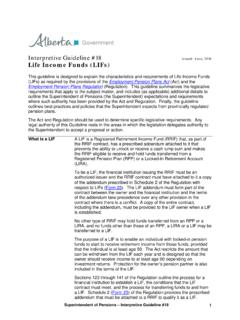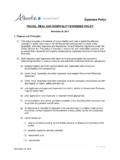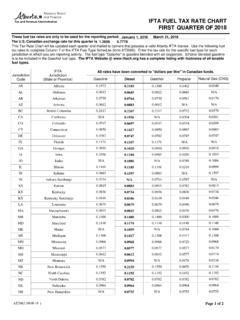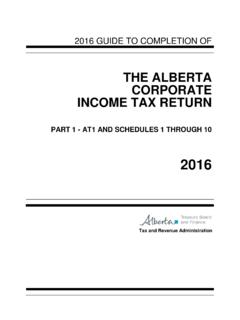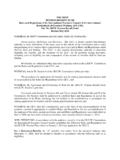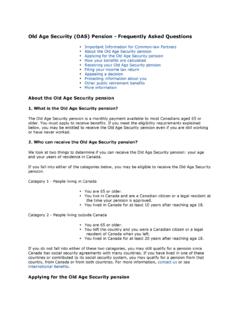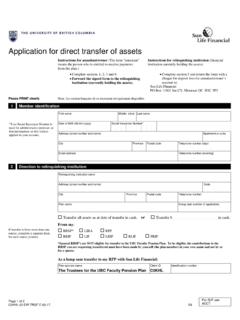Transcription of ACCESSING PENSION FUNDS - Alberta
1 ACCESSING . PENSION FUNDS . Updated: January 2018. Alberta Locked-in Accounts If you work for an industry that is not federally regulated*, and you work in Alberta on your last day of employment under the PENSION plan , then the FUNDS from that plan are subject to the Employment PENSION Plans Act (the Act). Alberta public sector plans (the Public Service, Teachers, Management Employees, Local Authorities, Special Forces, Provincial Court Judges and MLA. PENSION Plans) are not subject to the Act, but once the money is transferred out, it must be locked-in under the rules of the Act. *Federally regulated industries include banking, telecommunications, airlines, shipping, and inter-provincial forms of transportation. In addition, federal civil servants, the military, the RCMP, and employment in the Territories are under the federal regulation.
2 Contact the Government of Canada for information. If you worked in another province on your last day of work then your PENSION is regulated under that province and you must contact them for information. What Happens When I Leave my Employer? When you leave employment, you may be given the option to transfer your FUNDS from the PENSION plan into a Locked-in Retirement Account (LIRA). The LIRA is a locked-in RRSP at a financial institution. The transfer of the money from the PENSION plan to a LIRA does not change the fact that the PENSION plan was set up to provide you with income for your life after retirement. Therefore, all money transferred to a LIRA is to be used to provide you with retirement income. If you have a LIRA and are at least 50 years old, you can start receiving PENSION income.
3 To do so, you must buy a life annuity or transfer to a Life Income fund (LIF). Life Annuities Only insurance companies offer life annuities. These annuities provide you with a guaranteed income for life, which you buy with the money in your LIRA. Payments from a life annuity are like receiving a monthly PENSION that is paid directly from a PENSION plan fund . Once you have started to receive an annuity, the insurance company is unlikely to allow you to change it. 2. 2. The details of the annuity, as well as the amounts paid out, depend on the terms of the contract that you sign with the insurance company. However, the Act requires that any annuity purchased using locked-in FUNDS must pay you income for as long as you live. If you have a PENSION partner at the time you start your PENSION , the standard form of payment to you is a 60% joint and survivor annuity.
4 This pays an amount for both of your lives and continues payments after the first death to the survivor of 60% of the payment when you were both alive. You may choose a different amount only if your PENSION partner agrees to give up the guarantee by signing the waiver shown on page 8. No waiver is needed if you choose an annuity that pays more than 60% to the survivor. Life Income fund (LIF). Many financial institutions, including insurance companies, banks, trust companies and credit unions, offer LIFs. A LIF gives you more control over the investment of the money but does not guaranteed a specific amount of income. The LIF must pay a minimum yearly amount because of the rules of the Income Tax Act. The maximum amount that may be paid out is based on a factor that is calculated every year.
5 Your financial institution can explain LIF amounts. You cannot transfer to a LIF unless your PENSION partner agrees to give up his or her right to the 60 percent joint and survivor PENSION by signing waiver Form 10. When you die, your PENSION partner will receive the remainder of the LIF. account. Payment can be into their Registered Retirement Income fund (RRIF). or RRSP if your PENSION partner is under age 71. Or they can take the payment as cash, but taxes will be deducted as required by the Income Tax Act (ITA.). If you have no PENSION partner when you die, the money goes to the person you name as your beneficiary, or to your estate if you do not name a beneficiary. If you have a PENSION partner, but wish to name a beneficiary who is not your PENSION partner, and your PENSION partner is in agreement, they sign Form 16.
6 Who is my PENSION Partner? Your PENSION partner is: the person to whom you are married, and are not living separate and apart for 3 years, or if there is no one then the person with whom you have been living in a marriage-like relationship for at least 3 years, or sooner if there is a child resulting from the relationship either by birth or adoption. 3. 3. If you are living common-law, it ends on the date that you begin to live separate and apart. Please note that a PENSION partner can be a same sex person. However, if you got the locked-in account as a death benefit from your deceased PENSION partner, or as matrimonial property, then you do not have a PENSION partner for the purposes of the Act. ACCESSING Locked-in FUNDS If you have a locked-in account, there are five specific times that you may be allowed to unlock FUNDS .
7 These are: shortened life, non-residency, small amount, 50% unlocking on transfer to a LIF, and financial hardship. If you take the unlocked money as cash, income tax will be deducted. If you transfer the money into an RRSP or a RRIF there is no tax deducted. Be aware that taking the money out of a locked-in account means that your creditors may have access to the money. 1. Access due to Considerably Shortened Life If you have a terminal illness or a disability that will shorten your life, you may be able to unlock your PENSION , LIRA, LITB, or LIF. Your PENSION partner would have to give up his or her right to a joint and survivor PENSION by signing the form listed on page 8. Your doctor must write a letter that states you are expected to have a considerably shortened life.
8 The letter does not need to state the type of illness or disability nor how long you will live. You give the waiver and doctor's letter to the PENSION plan or financial institution that has your money. 2. Access by Becoming a Non-resident of Canada If the Canada Revenue Agency (CRA) determines that you are a non-resident of Canada for tax purposes, and confirms this in writing, then you may unlock your LIRA or LIF. You can apply for non-residency status by completing the federal form NR-73. E(12). This form is available on the CRA website. Follow their instructions. If you qualify, CRA will send you a letter confirming that you are a non-resident of Canada for purposes of the ITA. 4. 4. To unlock your money, you must give your PENSION plan or financial institution a copy of the CRA letter and the form shown on page 8 signed by your PENSION partner.
9 Please call the CRA at 1-800-267-5177 if you have questions about non- residency . 3. Access to Small Amounts Sometimes the money in a LIRA, LIF or a PENSION plan at termination, is too small to provide a useful PENSION . A small amount may be unlocked. Please note that the age 65 unlocking does not apply to money in a PENSION plan . For 2018, if you are under age 65 and the amount in any single locked-in account is less than $11,180 on the day you ask for the withdrawal, the account can be unlocked. If you are age 65 or older and the amount in any single locked-in account is less than $22,360 on the day you ask for the withdrawal, the account can be unlocked. There is no PENSION partner waiver as the amount is too small to provide a PENSION . The money is unlocked by the PENSION plan or financial institution that has your money.
10 The small amounts are based on 20% and 40% of the Year's Maximum Pensionable Earnings (YMPE). The YMPE is set each year by the Government of Canada for the Canada PENSION plan . What if my account balance is just above the small amounts limit? If the amount is over the limit, even by a dollar, then you cannot have your FUNDS unlocked under the small amount rule. You cannot split accounts to make them small enough to be unlocked. 4. Access by 50% Unlocking If you are aged 50 or older and have terminated from a PENSION plan or have money in a LIRA, you may unlock up to 50% of the money when you start a LIF or LITB. Your PENSION partner would have to give up his or her right to a joint and survivor PENSION by signing Form 7 (from a PENSION plan ) or Form 14 (from a LIRA.)
